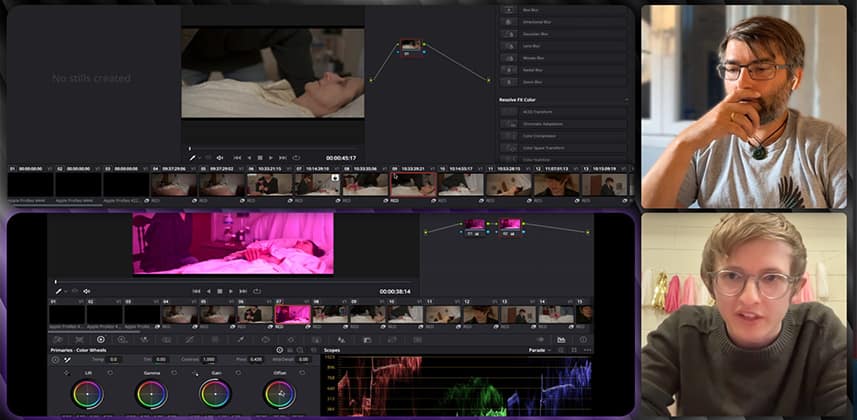| Series |
|---|
Part 2: Diving into Resolve’s ‘cloud collaboration’ workflow
In Part 1, we explored the initial challenge of any cloud-based multi-user (or team) workflow – sharing source footage. We also looked at the several ways of generating Proxys, including using Resolve’s Proxy Generator, reducing bandwidth requirements, and the resulting cloud storage costs, when sharing media with a team.
In this Insight, we dive into how Resolve’s collaboration workflow is executed, explicitly using the new Blackmagic Cloud database option.
Real-time international collaborative editing, color grading, media management
Luke Ross and Patrick Inhofer join Zeb Chadfield as Zeb demonstrate a collaborative project with a distributed team using a Blackmagic Cloud Resolve database. With Zeb in Greece, Patrick in Florida, Luke in New Zealand, and a database hosted in San Franciso, we put the system to a test.
This is Luke’s first time working in a Collaborative project – providing us with the newcomer’s perspective. The team shares how this workflow is executed while discovering, in real-time, if this new cloud-based solution works as advertised.
From folder-locking and timeline-locking to editing and color grading, we give Resolve a workout. Each of us deals with a crash (while the others never even notice).
Additional Notes about Collaboration Mode
During this call, the team discovered a few additional quirks that didn’t make the final edit of this Insight (to keep it from running too long):
- Project notes – These notes are local to each individual and are not shared with other Collaborators until the other Collaborators leave the project and then re-open it.
- Fusion page – If one collaborator is one the Fusion page, other collaborators can enter the Fusion page, but the node tree and viewers are blank. But there is not indication of who has ownership of that shot in Fusion.
- Deliver page – Render queues are not shared or displayed to other collaborators until they exit and then re-open the project.
Click through to see more Insights on this topic
This free Insight is just the tip of the iceberg! We’ve been teaching these topics for a decade.
Question, Comments, or Updates?
For reasons that Patrick is too embarrassed to share, this Insight was recorded this summer using Resolve Public Beta – and then forgotten about until Patrick read a comment in Part 1 asking for Part 2. But now, it’s here and released. Since this recording, there have been a series of consequential updates to DaVinci Resolve 18. If some of the features we discuss have been updated or new features added – use the comments to let us know!
Plus, if you have any other comments, thoughts, or questions – you know what to do! Don’t be shy 🙂
Table of Contents
(bold is a member question)
Member Content
Sorry... the rest of this content is for members only. You'll need to login or Join Now to continue (we hope you do!).
Need more information about our memberships? Click to learn more.
Membership optionsMember Login


